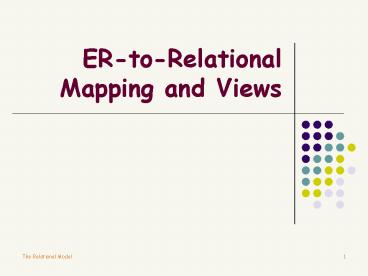ER-to-Relational Mapping and Views - PowerPoint PPT Presentation
1 / 11
Title:
ER-to-Relational Mapping and Views
Description:
Combining one of the entity sets and the relationship into a relation and using ... Provides fast access, like a (very high-level) cache. ... – PowerPoint PPT presentation
Number of Views:17
Avg rating:3.0/5.0
Title: ER-to-Relational Mapping and Views
1
ER-to-Relational Mapping and Views
2
Entity Sets to Tables
- Each attributes of the entity set becomes an
attribute of the table. - CREATE TABLE Employees
- (ssn CHAR(11),
- name CHAR(20),
- lot INTEGER,
- PRIMARY KEY (ssn))
3
Mapping of Relationship Sets
- Foreign Key approach
- Combining one of the entity sets and the
relationship into a relation and using foreign
key to refer to the other entity set(s). - Merged relation option
- Merging the entity sets and the relationship into
a single relation. - Cross-reference or relationship relation option
- The third alternative is to set up a relationship
relation for the purpose of cross-referencing the
primary keys of the other entity sets.
4
Relationship Sets to Tables
CREATE TABLE Works_In2( ssn CHAR(11), did
INTEGER, address CHAR(20), since DATE,
PRIMARY KEY (ssn, did, address), FOREIGN KEY
(ssn) REFERENCES Employees, FOREIGN
KEY (address) REFERENCES Locations,
FOREIGN KEY (did) REFERENCES
Departments)
- In translating a relationship set (without
constraints) to a relation, attributes of the
relation must include - Keys for each participating entity set (as
foreign keys). - This set of attributes forms a superkey for the
relation. - All descriptive attributes.
5
Translating ER Diagrams with Key Constraints
- Map relationship to a table
- did is the key
- Separate tables for Employees and Departments.
- Since each department has a unique manager, we
could instead combine Manages and Departments.
CREATE TABLE Manages( ssn CHAR(11), did
INTEGER, since DATE, PRIMARY KEY (did),
FOREIGN KEY (ssn) REFERENCES Employees,
FOREIGN KEY (did) REFERENCES Departments) CREAT
E TABLE Dept_Mgr( did INTEGER, dname
CHAR(20), budget REAL, ssn CHAR(11),
since DATE, PRIMARY KEY (did), FOREIGN KEY
(ssn) REFERENCES Employees)
6
Participation Constraints in SQL
- We can capture total participation constraint
involving one entity set in a binary
relationship. - CREATE TABLE Dept_Mgr(
- did INTEGER, dname CHAR(20), budget REAL,
- ssn CHAR(11) NOT NULL, since DATE, PRIMARY
KEY (did), - FOREIGN KEY (ssn) REFERENCES Employees,
- ON DELETE NO ACTION)
- The Works_In relation contains ssn and did, which
are foreign keys referring to Employees and
Departments. We cannot enforce the participation
constraints on the Works_In relation without
using table constraints or assertions.
7
Translating Weak Entity Sets
- Weak entity set and identifying relationship set
are translated into a single table. - When the owner entity is deleted, all owned weak
entities must also be deleted. - CREATE TABLE Dep_Policy (
- pname CHAR(20), birthday DATE, cost REAL,
- ssn CHAR(11) NOT NULL,
- PRIMARY KEY (pname, ssn),
- FOREIGN KEY (ssn) REFERENCES Employees
- ON DELETE CASCADE)
8
Additional Example
- CREATE TABLE Policies (
- policyid INTEGER, cost REAL, ssn CHAR(11) NOT
NULL, - PRIMARY KEY (policyid).
- FOREIGN KEY (ssn) REFERENCES Employees, ON
DELETE CASCADE) - CREATE TABLE Dependents (
- pname CHAR(20), age INTEGER, policyid INTEGER,
- PRIMARY KEY (pname, policyid).
- FOREIGN KEY (policyid) REFERENCES Policies,
- ON DELETE CASCADE)
9
Views
- A view is just a relation, but we store a
definition, rather than a set of tuples. - CREATE VIEW YoungActiveStudents (name, grade)
- AS SELECT S.name, E.grade
- FROM Students S, Enrolled E
- WHERE S.sid E.sid and S.agelt21
- Views can be dropped using the DROP VIEW command.
- How to handle DROP TABLE if theres a view on the
table? - DROP TABLE command has options to let the user
specify this.
10
Views and Security
- Views can be used to present necessary
information (or a summary), while hiding details
in underlying relation(s). - Given YoungStudents, but not Students or
Enrolled, we can find young students who are
enrolled, but not the cids of the courses they
are enrolled in.
11
Materialized Views
- A view whose tuples are stored in the database is
said to be materialized. - Provides fast access, like a (very high-level)
cache. - Need to maintain the view as the underlying
tables change. - Ideally, we want incremental view maintenance
algorithms. - What views should we materialize, and what
indexes should we build on the precomputed
results? - Given a query and a set of materialized views,
can we use the materialized views to answer the
query? - How frequently should we refresh materialized
views to make them consistent with the underlying
tables? (And how can we do this incrementally?)































